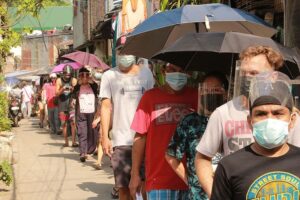Cari amici, nonostante la totale chiusura di Pasqua, a Manila si continua a lottare contro il contagio. E secondo gli esperti il coronavirus potrebbe colpire un milione di persone nel mio Paese, entro la fine di questo mese. Gli ospedali sono quasi tutti pieni e si sta cercando di decongestionarli, installando tende modulari all’esterno e convogliando i pazienti meno gravi verso strutture di quarantena. Per affrontare la nuova ondata di contagi si stanno potenziando la rete di telemedicina per i consulti on line. Il Governo sta inoltre intensificando la diagnostica gratuita per gli operatori medici, economici in prima linea e per chi ha i sintomi.
The one-week enhanced community quarantine (ECQ) may have slowed the rate of increase in COVID-19 cases in the National Capital Region (NCR), but this will not be enough to stop the total from breaching the one-million mark this month, OCTA research group said yesterday.
The OCTA team is an independent and interdisciplinary research group that has been studying the COVID-19 outbreak in the Philippines. It is composed primarily of the University of the Philippines (UP) faculty members and alumni with contributors from the University of Santo Tomas (UST) and Providence College, USA.
Guido David, OCTA Research fellow, said this projection had already taken into consideration the conservative estimate reproduction number of 1.2 to 1.3 of new COVID-19 cases in the NCR, which remains the epicenter of the coronavirus in the country.
We will have to see how fast it (reproduction number) decreases. Right now, the trajectory is we’re seeing maybe 1.3 or 1.2 by the end of this coming week. So, we’re hoping that it will improve much better than that. There are indicators that it may decrease faster than that. But that’s only a conservative estimate, David said at the Laging Handa (Always Prepared) virtual press briefing with Presidential Communications Operations Office Undersecretary Rocky Ignacio yesterday.
The one million total cases that will be breached before the end of April are based on the projections that we’re seeing, David said.
OCTA researchers said their monitoring of new coronavirus cases from March 29 to April 4 showed a positive effect of the ECQ declared over the NCR and the adjacent provinces of Bulacan, Cavite, Laguna and Rizal.
David said the one-week ECQ already had a positive effect on their March 29 to April 4 monitoring.
ECQ or GCQ (general community quarantine) really has a positive effect. But during the time of GCQ bubble, the reproduction number improved by 0.1 from 2 to 1.9 approximately, David said. But with the ECQ improving from 1.9 to 1.6, this means that the trend is slowing down.
If we compare the growth rate in one week, there is a decrease of 20 percent. The number of new cases this week of about 5,500, it’s only at 20 percent increase from last week in the NCR, he explained. Hopefully with the additional one week of ECQ, we can reduce further the reproduction number to 1 or close to 1.
However, Rodrigo Angelo Ong, also of OCTA Research, said they are not inclined to see the decrease in reproduction as enough good news.
Our one week (break) during the Holy Week, we hoped that the reproduction number had gone down to 1.3 or 1.4. But it’s still at 1.6. However, the real effect of the ECQ last week will be felt this week and next week. It’s still too early to say what will happen by the end of the week, Ong said. But the trends are going down.
David stressed that the lower reproduction number for the past week was just the start of an improvement.
We don’t have a downward trend. The rate of increase is going down, but we’re still not in a downward trend, he said.
With the OCTA report for the week of March 29 to April 4, the group said it saw a reproduction number of 1.61.
The NCR as a whole is now in a period where the increase in new COVID-19 cases is slowing down (from an initial phase of rapid increase that was experienced in March), the group noted.
However, OCTA noted a significant increase in cases in Laguna, Batangas and also Pampanga.
Outside the NCR Plus bubble, Batangas and Pampanga both had one week growth rates above 50 percent. Batangas had a positivity rate greater than 20 percent, the group noted.
NCR remained as the epicenter of the pandemic, with a daily attack rate of 40.1 new COVID-19 cases per 100,000 people. The good news is that the one-week growth rate decreased to 20 percent, OCTA said in its report.
While NCR cities are still showing, the greatest number of new COVID-19 cases, the trends started to slow down in several cities. Lower one week growth rates were observed in Manila, Parañaque, Marikina and Navotas, while Pasay and Makati had downward trends (negative one week growth rates). On the other hand, rapid increases in new COVID-19 cases were still observed in Mandaluyong, Las Piñas and San Juan. The goal is for these LGUs to have low or negative one week growth rates in new COVID-19 cases very soon, OCTA said.






